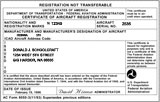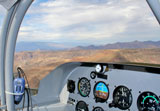|
Airworthiness DirectivesThe Federal Aviation Administration (FAA) is responsible for the promotion of aviation safety. One of ways they do this is through the airworthiness directives (AD) system. FAR 39 mandates the compliance with airworthiness directives. The FAA issues AD's when an unsafe condition is found to exist in a product (aircraft, aircraft engine, propeller, or appliance.) These AD's notify aircraft owners and operators of potential unsafe conditions and require special inspections, repairs, or alterations to correct the unsafe condition. The registered owner or operator of an aircraft is responsible for compliance with AD's applicable to the airframe, engine, propeller, appliances, parts and components for all aircraft it owns or operates. Maintenance personnel are responsible for determining that all applicable airworthiness requirements are met when they accomplish an inspection in accordance with FAR 43.
AD CategoriesAD's are issued depending on their urgency as follows: Regular AD. A notice of proposed rulemaking (NPRM) for an AD is issued and published in the Federal Register when an unsafe condition is found to exist in a product. Interested persons are invited to comment on the NPRM by submitting their written data and views on the condition. The notice may be changed or withdrawn in light of comments received. After the comment period, a final rule is adopted and published in the Federal Register. It is also printed and distributed by first class mail to the registered owners and certain known operators of the product(s) affected. Emergency AD. AD's of an urgent nature may be adopted without prior notice (without an NPRM) under emergency procedures as immediately adopted rules. The AD's normally become effective in less than 30 days after publication in the Federal Register and are distributed by first class mail, telegram, or other electronic methods to the registered owners and certain known operators of the product affected. In addition, notification is also provided to special interest groups, other government agencies, and Civil Aviation Authorities of certain foreign countries.
Products Other Than AircraftAD's may be issued for unsafe conditions that exist on aircraft engines, propellers, or appliances installed on multiple makes or models of aircraft. When the product can be identified as being installed on a specific make or model aircraft, the AD is distributed by first class mail to the registered owners of those aircraft. However, there are times when such a determination cannot be made, and direct distribution to registered owners is impossible. It is advisable for aircraft owners and operators to visit the FAA website where they can find a summary of airworthiness directives with biweekly updates. The website address is: http://www.faa.gov/regulations_policies/airworthiness_directives/ They can also subscribe to the summary of airworthiness directives service by contacting the FAA, Manufacturing Standards Section (AFS-613), P.O. Box 26460, Oklahoma City, Oklahoma 73125-0460. Telephone (405) 954-4103, FAX (405) 954-4104.
Applicability of AD'sEach AD contains an applicability statement specifying the aircraft, aircraft engine, propeller, or appliance it applies to. Unless specifically stated, AD's apply to the make and model set forth in the applicability statement regardless of the classification or category of the airworthiness certificate issued for the aircraft. Limitations may be placed on applicability by specifying the serial number or number series the AD is applicable to. When there is no reference to serial numbers, all serial numbers are affected. They may also refer you to a manufacturer's service bulletin to find out which products the AD applies to.
AD ComplianceAD's are regulations issued under FAR 39, and no person may operate a product to which an AD applies, except in accordance with the requirements of that AD. Awareness of and compliance with emergency AD's is particularly important and owners and operators should have a system in place to know if an applicable emergency AD has been issued.
Compliance Time or DateThe required compliance time is specified in each AD, and no person may operate the affected product after that stated compliance time unless the instructions in the AD are complied with. Some AD's are of such a serious nature they require compliance before further flight, for example: "To prevent uncommanded engine shutdown with the inability to restart the engine, prior to further flight, inspect...." Other AD's express compliance time in terms of a specific number of hours in operation or within certain number of landings. For turbine engines, compliance times are often expressed in terms of cycles. A cycle normally consists of an engine start, takeoff operation, landing, and engine shutdown. When a direct relationship between airworthiness and calendar time is identified, compliance time may be expressed as a calendar date. In most instances, the AD will authorize a flight after the compliance date has passed provided that a special flight permit is obtained. The special flight permit will authorize the operator to fly the aircraft to a maintenance facility where the AD can be performed.
Adjustments in Compliance RequirementsIn some instances, a compliance time other than the compliance time specified in the AD may be advantageous to an aircraft owner or operator. In recognition of this need, and when an acceptable level of safety can be shown, flexibility may be provided by a statement in the AD allowing adjustment of the specified interval. When adjustment authority is provided in an AD, owners or operators desiring to make an adjustment are required to submit data substantiating their proposed adjustment to their local FAA Flight Standards District Office or other FAA office for consideration as specified in the AD. The FAA office or person authorized to approve adjustments in compliance requirements is normally identified in the AD.
Alternative Methods of Compliance (AMOC)Many AD's indicate the acceptability of one or more alternative methods of compliance. Any alternative method of compliance or adjustment of compliance time other than that listed in the AD must be substantiated and approved by the FAA before it may be used. Normally the office or person authorized to approve an alternative method of compliance is indicated in the AD.
Responsibility for AD ComplianceThe owner or operator of an aircraft is primarily responsible for maintaining that aircraft in an airworthy condition, including compliance with AD's. This responsibility may be met by ensuring that properly certificated and appropriately rated maintenance person(s) accomplish the requirements of the AD and properly record this action in the appropriate maintenance records. This action must be accomplished within the compliance time specified in the AD or the aircraft may not be operated. Maintenance persons may also have direct responsibility for AD compliance, aside from the times when AD compliance is the specific work contracted for by the owner or operator. When a 100-hour, annual, progressive, or any other inspection required under FAR's 91, 121, 125, or 135 is accomplished, FAR 43.15(a) requires the person performing the inspection to determine that all applicable airworthiness requirements are met, including compliance with AD's.
Recording AD ComplianceThe person accomplishing the AD is required by FAR 43.9 to record AD compliance. The entry must include those items specified in FAR 43.9 (a) (1) through (a) (4). The owner or operator is required by FAR 91.405 to ensure that maintenance personnel make appropriate entries and, by FAR 91.417, to maintain those records. Owners and operators should note that there is a difference between the records required to be kept by the owner under FAR 91.417 and those required to be made by maintenance personnel by FAR 43.9. In either case, the owner or operator is responsible for maintaining proper records.
Repetitive AD’sSome AD's require repetitive or periodic inspection. Some repetitive AD's may provide for adjustment of the inspection interval to coincide with an operators inspection program. The conditions and approval requirements under which adjustments may be allowed are stated in the AD. If the AD does not contain such provisions, adjustments are usually not permitted. However, amendment, modification, or adjustment of the terms of the AD may be requested by contacting the office that issued the AD or by following the petition procedures provided in FAR11.
AD RevisionsThe revision date required by FAR 91.417 (a)(2)(v) is the effective date of the latest amendment to the AD and may be found in the last sentence of the body of each AD. Similarly, the revision date for an emergency AD distributed by telegram or priority mail is the date it was issued. Each emergency AD is normally followed by a final rule version that will reflect the final status and amendment number of the regulation including any changes in the effective date.
|









